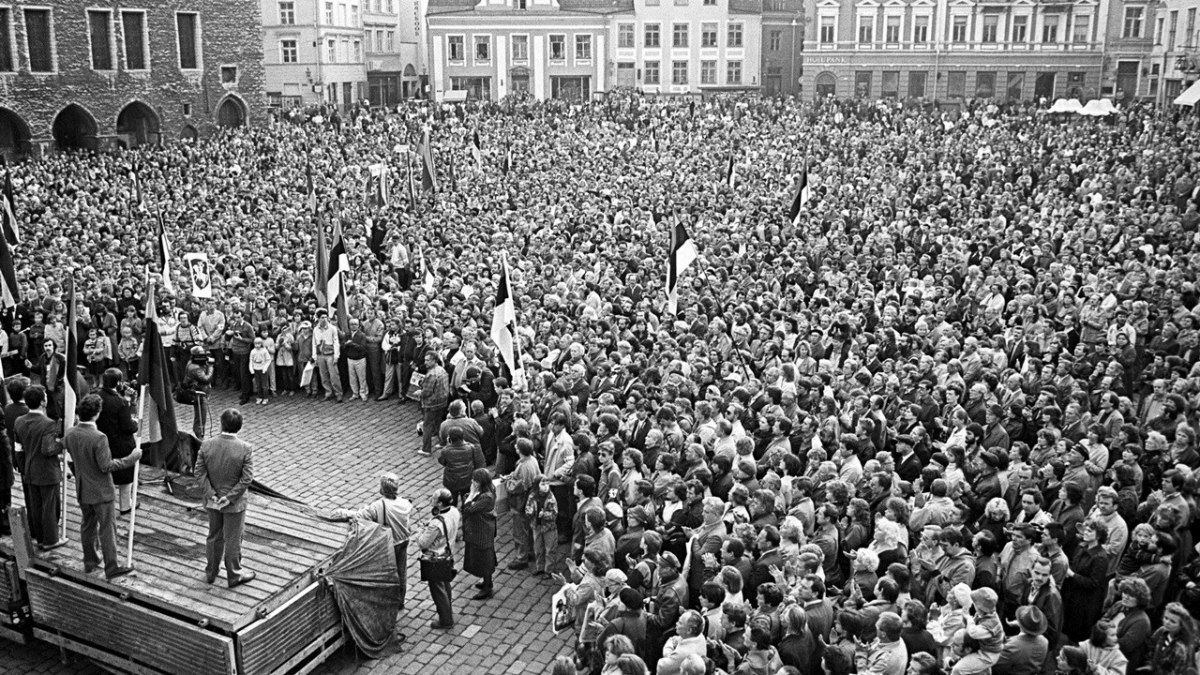The theme of rising nationalist sentiment in the countries of the Soviet Bloc is repetitive. The rejuvenation of national symbols, national pride, and sovereignty plagued Soviet rule throughout the its history. Whether the Polish and Hungarian demonstrations and interventions in 1956, or the Prague Spring in 1968 these movements were largely based on the assertion of a national identity separate from the USSR. In both of these cases the object was greater autonomy, while remaining Communist. Both were put down with violence. However the crumbling of the power and authority of the USSR in the 1980s led three of the youngest Soviet Republics to be the first to leave, with minimal bloodshed. These republics, Estonia, Latvia, and Lithuania on the Baltic Sea argued for total independence from the USSR, using unique methods, the power of patriotic song and civil disobedience.
The Baltic Republics are unique in the Soviet Bloc, having been able to preserve much of their national culture, history, and language. The tradition of annual song festivals may have been a key contributor in uniting the people of these nations, and helping them preserve their distinct identity in the face Soviet occupation and oppression. It is likely that the strong national sentiment was what led these small nations to completely defy the power of the Soviet Union. The language used by the Estonians in their decree on Estonian-USSR relations in August 1990 is much more forceful than anything disgruntled Soviet Bloc reformers had used before. Declaring the Estonian SSR Constitution “totally non-binding for the Republic of Estonia” . This decree followed in the wake of the “Baltic Way” protests of 1989, where 300,000 Estonians gathered to sing patriotic songs in defiance of the Soviet Union, and in August nearly 2 million citizens of the three republics joined hands across their homeland.
The declarations of independence and sovereignty of the these three Baltic republics occurred nearly at the same time, beginning with Lithuania in March of 1990. Following an attempted coup by pro-Russian factions in August 1991, Gorbachev and the USSR had neither the will nor the means to prevent these republics from breaking away. Soon after, both Latvia and Estonia joined Lithuania in declaring their independence.
Something I find particularly interesting in the popular reform movements throughout the Soviet Bloc nations is the role played by nationalist and patriotic sentiment and imagery. The Hungarians, facing down the Soviets in 1956 felt the need to revive their old national symbol of Kossuth, similarly the Estonians in 1988 felt the need to address and restore their national flower and bird “cornflowers, and the barn swallow.” It is interesting how such seemingly innocuous things presented such a threat to the USSR and their internationalism.

For those interested here is a video describing the Estonian National Singing Festivals I found on Youtube.
Source: Featured Image


Interesting subject of your post considering tensions between Russia and the Baltic states continue today. I like how you pointed out nationalism and patriotism played a role in a lot of these socialist republics’ attempts to break free from the Soviet Union. Despite every measure of the USSR to wipe out any sense of individualism or nationalism among the Soviet states it still existed, as seen by your post. Great post!
LikeLike
Thanks so much for this, Kevin — I really appreciate how you tie the various strands of national identity and protest together to talk about the pressures for liberation of the Baltic states at the end of the Soviet period. The Estonian song festival is especially cool. A student who took this class a couple years ago actually went to one — about a million people turned out (and the total population is only 1.3 million!). There’s a video at the end that’s worth checking out: http://blogs.lt.vt.edu/jmhawkins/2014/10/19/treblemakers-in-a-national-cause/
LikeLike
I liked this post a lot. I loved the images you chose as well. I appreciate how you linked seemingly small things and sentiments to what led to such a great impact, like becoming independent of the Soviet Union. I like to think about those things and have them brought to light because such small things can have such a joining force and negative effect on a country that is struggling.
LikeLike
I think that was the thing I thought was most interesting in writing this post. How the little sentimental and seemingly insignificant things like national flower and ancient symbols could be such a powerful emotional and motivating force. If you didn’t check out the video at the bottom I’d recommend it.
LikeLike